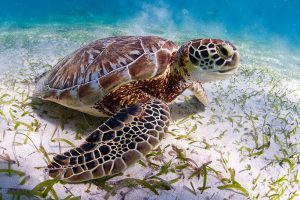 ©WWF
©WWF
Hoy, 16 de junio, se celebra el Día Mundial de las Tortugas Marinas. Estos animales, que son uno de los más longevos, se encuentran gravemente amenazados. Las tortugas llevan en el planeta desde la era de los dinosaurios, aproximadamente 200 millones de años.
Muchos son los riesgos del océano que ponen en peligro a las tortugas marinas. La basura oceánica, los plásticos, la pesca con redes donde se quedan atrapadas, el cambio de la temperatura de los océanos y el aumento del turismo en playas son algunos de los riesgos que hacen que las tortugas marinas estén gravemente amenazadas y en riesgo de desaparición.
La celebración coincide con el nacimiento, en el año 1909, del conservacionista de tortugas marinas Archie Carr, cuya labor permitió desarrollar numerosas medidas relacionadas con la protección de esta especie.
Actualmente, existen siete especies de tortugas marinas, seis de las cuales se encuentran en peligro de extinción: Tortuga Plana, Tortuga Verde, Tortuga Carey, Tortuga Boba, Tortuga Laud, Tortuga Olivácea y Tortuga Bastarda.
Algunas curiosidades sobre las tortugas son que su caparazón forma parte de su esqueleto, compuesto por 50 huesos; son reptiles omnívoros y se alimentan de corales, algas, calamares y medusas; en épocas de reproducción e incubación de huevos suelen volver al lugar donde nacieron, pudiendo incubar más de 100 huevos en un período de 60 días; una de cada 1000 crías sobrevive y alcanza la edad adulta; pueden migrar largas distancias, alcanzando velocidades entre 27 km/h y 35 km/h y por último, pueden vivir entre 150 y 200 años.
El objetivo principal de esta efeméride es concienciar a la población del peligro al que se están enfrentando las tortugas y todas las amenazas que las acechan; por otro lado, se pretende involucrar a la humanidad en el cuidado y supervivencia de la especie, apelando el apoyo de organizaciones ambientales.
__
WORLD SEA TURTLE DAY
Today, June 16, is World Sea Turtle Day. These animals, which are among the longest-lived, are seriously endangered. Turtles have been on the planet since the age of the dinosaurs, approximately 200 million years ago.
Many ocean hazards endanger sea turtles. Ocean garbage, plastics, fishing with nets where they get trapped, the change in ocean temperature and the increase in tourism on beaches are some of the risks that make sea turtles seriously threatened and at risk of disappearing.
The celebration coincides with the birth, in 1909, of sea turtle conservationist Archie Carr, whose work led to the development of numerous measures related to the protection of this species.
There are currently seven species of sea turtles, six of which are in danger of extinction: Flatback Turtle, Green Turtle, Hawksbill Turtle, Loggerhead Turtle, Leatherback Turtle, Olive Ridley Turtle and Olive Ridley Turtle.
Some curiosities about turtles are that their shell is part of their skeleton, composed of 50 bones; they are omnivorous reptiles and feed on corals, algae, squid and jellyfish; in times of reproduction and egg incubation they usually return to the place where they were born, being able to incubate more than 100 eggs in a period of 60 days; one out of every 1000 hatchlings survives and reaches adulthood; they can migrate long distances, reaching speeds between 27 km/h and 35 km/h and finally, they can live between 150 and 200 years.
The main objective of this ephemeris is to raise public awareness of the danger turtles are facing and all the threats they are facing; on the other hand, it is intended to involve mankind in the care and survival of the species, appealing to the support of environmental organizations.
__

